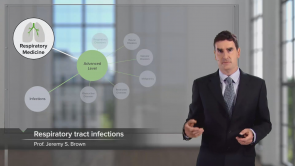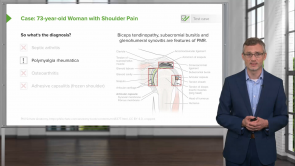Interstitial Disease (Part 2)
Über den Vortrag
Der Vortrag „Interstitial Disease (Part 2)“ von Hetal Verma, MD ist Bestandteil des Kurses „Thoracic Radiology“. Der Vortrag ist dabei in folgende Kapitel unterteilt:
- Pulmonary Fibrosis
- Multiple Interstitial Nodules
Quiz zum Vortrag
Which of the following is a common imaging finding of pulmonary fibrosis?
- Honeycombing
- Consolidation
- Fine reticular pattern
- Pleural effusion
- Pulmonary nodules
Which statement regarding pulmonary fibrosis is TRUE?
- It reveals a honeycomb pattern on imaging.
- The opacities become confluent over a period of time.
- It forms a solid pattern.
- The bronchi get compressed from the surrounding fibrosis.
- The most common cause is a fungal infection.
Which of the following regarding sarcoidosis is FALSE?
- There are five stages of the disease.
- Bilateral hilar lymphadenopathy is the most common finding.
- Right paratracheal lymphadenopathy can be present.
- It often has a reticular and nodular interstitial pattern.
- The disease starts with lymphadenopathy and progresses to interstitial disease.
Kundenrezensionen
4,0 von 5 Sternen
| 5 Sterne |
|
0 |
| 4 Sterne |
|
1 |
| 3 Sterne |
|
0 |
| 2 Sterne |
|
0 |
| 1 Stern |
|
0 |
Really great lecture, but the speed is bit hard to keep up with. Found myself pausing a lot, however the quality was excellent






